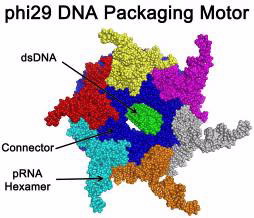FOR IMMEDIATE RELEASE
ACS News Service Weekly PressPac: March 20, 2013
Discovery of first motor with revolution motion in a virus-killing bacteria advances nanotechnology
“Mechanism of One-Way Traffic of Hexameric Phi29 DNA Packaging Motor with Four Electropositive Relaying Layers Facilitating Anti-Parallel Revolution”
ACS Nano
Scientists have cracked a 35-year-old mystery about the workings of the natural motors that are serving as models for development of a futuristic genre of synthetic nanomotors that pump therapeutic DNA, RNA or drugs into individual diseased cells. Their report revealing the innermost mechanisms of these nanomotors in a bacteria-killing virus — and a new way to move DNA through cells — is being published online today in the journal ACS Nano.
Peixuan Guo and colleagues explain that two motors have been found in nature: A linear motor and a rotating motor. Now they report discovery of a third type, a revolving molecular motor. Guo pointed out that nanomotors will open the door to practical machines and other nanotechnology devices so small that 100,000 would fit across the width of a human hair. One major natural prototype for those development efforts has been the motor that packages DNA into the shell of bacteriophage phi29, a virus that infects and kills bacteria. Guo’s own research team wants to embed a synthetic version of that motor into nanomedical devices that are injected into the body, travel to diseased cells and pump in medication. A major barrier in doing so has been uncertainty and controversy about exactly how the phi29 motor moves. Scientists thought that it worked by rotating or spinning in the same motion as the Earth turning on its axis.
In their ACS Nano paper, Guo, with his team Zhengyi Zhao, Emil Khisamutdinov and Chad Schwartz, challenges that idea. Indeed, they discovered that the phi29 motor moves DNA without any rotational motion. The motor moves DNA with a revolving in the same motion as the Earth revolving around the sun. “The revolution without rotation model could resolve a big conundrum troubling the past 35 years of painstaking investigation of the mechanism of these viral DNA packaging motors,” the report states.
The authors acknowledge funding from the National Institute of Biomedical Imaging and Bioengineering, National Institutes of Health.
Illustrated videos of the mechanism can be found at http://nanobio.uky.edu/movie2013.html.
Journalists can obtain a copy of the paper from newsroom@acs.org.
![]()
Contact
Science Inquiries: Michael Woods, Editor, 202-872-6293
General Inquiries: Michael Bernstein, 202-872-6042

about the workings of the natural motors that are
models for development of a futuristic genre of
synthetic nanomotors that pump therapeutic
DNA, RNA or drugs into individual diseased cells.

